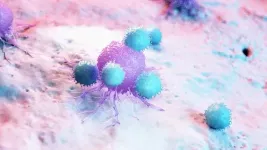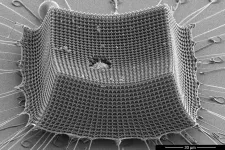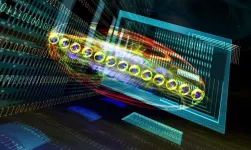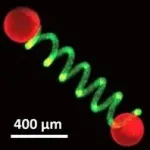(Press-News.org) The 'anterior cingulate cortex' is key brain region involved in linking behaviours to their outcomes.
When this region was temporarily silenced, monkeys did not change behaviour even when it stopped having the expected outcome.
The finding is a step towards targeted treatment of human disorders involving compulsive behaviour, such as OCD and eating disorders, thought to involve impaired function in this brain region.
Researchers have discovered a specific brain region underlying 'goal-directed behaviour' - that is, when we consciously do something with a particular goal in mind, for example going to the shops to buy food.
The study, published today in the journal Neuron, found that marmoset monkeys could no longer make an association between their behaviour and a particular outcome when a region of their brain called the anterior cingulate cortex was temporarily switched off.
This finding is important because the compulsive behaviours in OCD and addiction are thought to result from impairments in the 'goal-directed system' in the brain. In these conditions worrying, obsessions or compulsive behaviour such as drug seeking may reflect an alternative, habit-based system at work in the brain in which behaviours are not correctly linked with their outcomes.
It also sheds more light on how healthy people behave in a goal-directed way, which is needed to respond to changing environments and goals.
"We have identified the very specific region of the brain involved in goal-directed behaviour. When we temporarily turned this off, behaviour became more habitual - like when we go onto autopilot," said Lisa Duan in the University of Cambridge's Department of Psychology, first author of the report.
Marmosets were used because their brains share important similarities with human brains, and it is possible to manipulate specific regions of their brains to understand causal effects.
In the experiment, marmosets were first taught a goal-directed behaviour: by tapping a coloured cross when it appeared on a touchscreen, they were rewarded with their favourite juice to drink. But this connection between action and reward was randomly uncoupled so that they sometimes received the juice without having to respond to the image. They quickly detected this change and stopped responding to the image, because they saw they could get juice without doing anything.
Using drugs, the researchers temporarily switched off the anterior cingulate cortex including its connections with another brain region called the caudate nucleus. Repeating the experiment, they found when the connection between tapping the cross and receiving juice was randomly uncoupled, the marmosets did not change their behaviour but kept tapping the cross when it appeared.
Such habitual responding to the coloured cross was not observed when several other neighbouring regions of the brain's prefrontal cortex - known to be important for other aspects of decision-making - were switched off. This shows the specificity of the anterior cingulate region for goal-directed behaviour.
A similar effect has been observed in computer-based tests on patients with Obsessive Compulsive Disorder (OCD) or addiction - when the relationship between an action and an outcome is uncoupled the patients continue to respond as though the connection is still there.
Previous evidence from patients suffering brain damage, and from brain imaging in healthy volunteers, shows that part of the brain called the prefrontal cortex is involved in goal-directed behaviour. However, the prefrontal cortex is a complex structure with many regions, and it has not previously been possible to identify the specific part responsible for goal-directed behaviour from human studies alone.
"We think this is the first study to have established the specific brain circuitry that controls goal-directed behaviour in primates, whose brains are very similar to human brains," said Professor Angela Roberts in the University of Cambridge's Department of Physiology, Development and Neuroscience, joint senior author of the report.
"This is a first step towards identifying suitable molecular targets for future drug treatments, or other forms of therapy, for devastating mental health disorders such as OCD and addiction," added Professor Trevor Robbins in the University of Cambridge's Department of Psychology, joint senior author of the report.
INFORMATION:
LA JOLLA, CA--New research led by scientists at La Jolla Institute for Immunology (LJI) and the University of Liverpool may explain why many cancer patients do not respond to anti-PD-1 cancer immunotherapies--also called checkpoint inhibitors.
The team reports that these patients may have tumors with high numbers of T follicular regulatory (Tfr) cells.
In a healthy person, Tfr cells do the important job of stopping haywire T cells and autoantibodies from attacking the body's own tissues. But in a cancer patient, Tfr cells dramatically dial back the body's ability to kill cancer cells.
Anti-PD-1 cancer immunotherapies boost the body's cancer-fighting T cells, but ...
'Precision agriculture' where farmers respond in real time to changes in crop growth using nanotechnology and artificial intelligence (AI) could offer a practical solution to the challenges threatening global food security, a new study reveals.
Climate change, increasing populations, competing demands on land for production of biofuels and declining soil quality mean it is becoming increasingly difficult to feed the world's populations.
The United Nations (UN) estimates that 840 million people will be affected by hunger by 2030, but researchers have developed a roadmap combining smart and nano-enabled agriculture with AI and machine learning capabilities that could help to reduce this ...
A new study by engineers at MIT, Caltech, and ETH Zürich shows that "nanoarchitected" materials -- materials designed from precisely patterned nanoscale structures -- may be a promising route to lightweight armor, protective coatings, blast shields, and other impact-resistant materials.
The researchers have fabricated an ultralight material made from nanometer-scale carbon struts that give the material toughness and mechanical robustness. The team tested the material's resilience by shooting it with microparticles at supersonic speeds, and found that the material, which is thinner than the width of a human hair, prevented the miniature projectiles from tearing through ...
HAMILTON, ON June 24, 2021 -- The idea of visiting the doctor's office with symptoms of an illness and leaving with a scientifically confirmed diagnosis is much closer to reality because of new technology developed by researchers at McMaster University.
Engineering, biochemistry and medical researchers from across campus have combined their skills to create a hand-held rapid test for bacterial infections that can produce accurate, reliable results in less than an hour, eliminating the need to send samples to a lab.
Their proof-of-concept research, published today in the journal Nature Chemistry, specifically describes the test's ...
In a few years, a new generation of quantum simulators could provide insights that would not be possible using simulations on conventional supercomputers. Quantum simulators are capable of processing a great amount of information since they quantum mechanically superimpose an enormously large number of bit states. For this reason, however, it also proves difficult to read this information out of the quantum simulator. In order to be able to reconstruct the quantum state, a very large number of individual measurements are necessary. The method used to read out the quantum state of a ...
A University of Bristol-led team of international scientists with an interest in protoliving technologies, has today published research which paves the way to building new semi-autonomous devices with potential applications in miniaturized soft robotics, microscale sensing and bioengineering.
Micro-actuators are devices that can convert signals and energy into mechanically driven movement in small-scale structures and are important in a wide range of advanced microscale technologies.
Normally, micro-actuators rely on external changes in bulk properties such as pH and temperature to trigger repeatable mechanical ...
What The Study Did: Researchers found no association between recent vaccination with the Pfizer-BioNTech BNT162b2 COVID-19 vaccine and risk of facial nerve palsy.
Authors: Asaf Shemer, M.D., of the Shamir Medical Center in Be'er Ya'akov, Israel, is the corresponding author.
To access the embargoed study: Visit our For The Media website at this link https://media.jamanetwork.com/
(doi:10.1001/jamaoto.2021.1259)
Editor's Note: Please see the article for additional information, including other authors, author contributions and affiliations, conflict of interest and financial disclosures, and funding and support.
INFORMATION:
Media ...
What The Study Did: Researchers estimated the change in life expectancy associated with the COVID-19 pandemic in the United States by race/ethnicity.
Authors: Theresa Andrasfay, Ph.D., of the University of Southern California, Los Angeles, is the corresponding author.
To access the embargoed study: Visit our For The Media website at this link https://media.jamanetwork.com/
(doi:10.1001/jamanetworkopen.2021.14520)
Editor's Note: The article includes funding/support disclosures. Please see the article for additional information, including other authors, author contributions and affiliations, conflict of interest and financial disclosures, and funding and support.
INFORMATION:
Media advisory: The full study is linked to this news release.
Embed ...
What The Study Did: Patients with COVID-19-related loss of smell were evaluated for one year after the diagnosis.
Authors: Marion Renaud, M.D., of University Hospitals of Strasbourg, France, is the corresponding author.
To access the embargoed study: Visit our For The Media website at this link https://media.jamanetwork.com/
(doi:10.1001/jamanetworkopen.2021.15352)
Editor's Note: The article includes funding/support disclosures. Please see the article for additional information, including other authors, author contributions and affiliations, conflict of interest and financial disclosures, and funding and support.
INFORMATION:
Media advisory: The full study is linked to this news release.
Embed this link to provide ...
What The Study Did: The incidence of Bell palsy among patients with COVID-19 was compared with individuals vaccinated against the disease.
Authors: Akina Tamaki, M.D., of the University Hospitals Cleveland Medical Center, is the corresponding author.
To access the embargoed study: Visit our For The Media website at this link https://media.jamanetwork.com/
(doi:10.1001/jamaoto.2021.1266)
Editor's Note: The article includes conflicts of interest disclosures. Please see the article for additional information, including other authors, author contributions and affiliations, conflict of interest and financial disclosures, and funding and support.
INFORMATION:
Media advisory: ...




